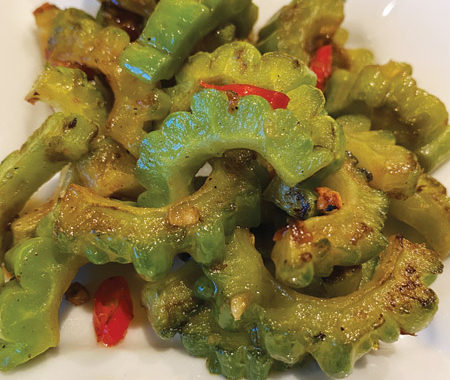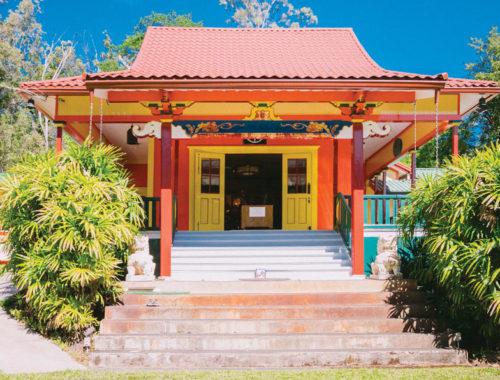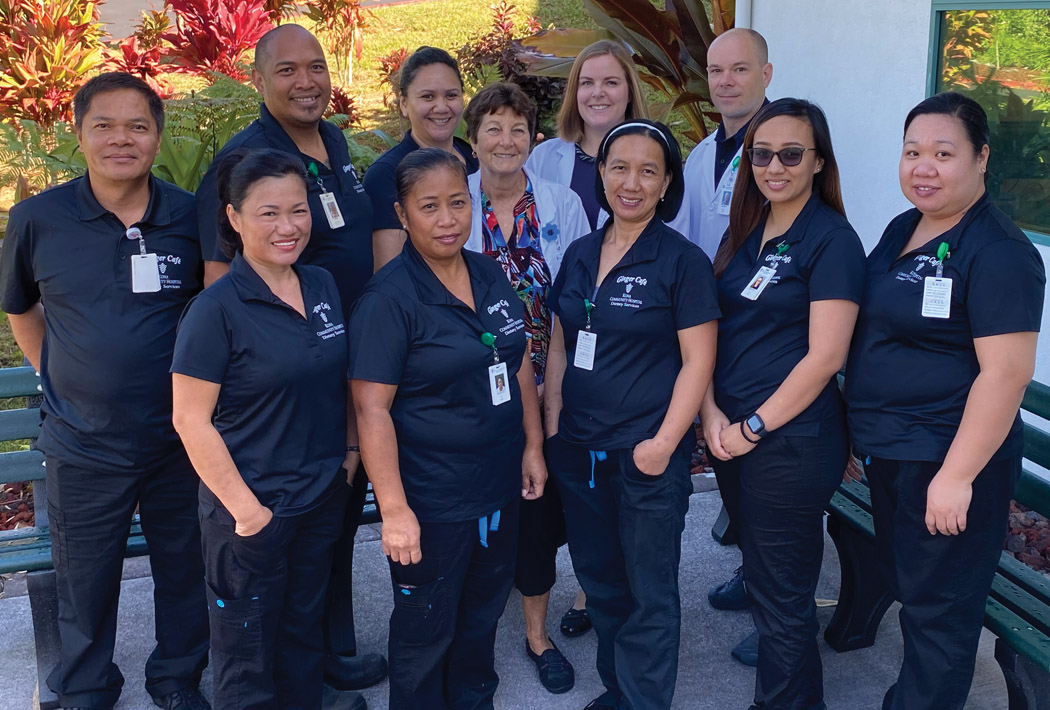
Farm to Table at Kona Community Hospital

By Brittany P. Anderson
The sounds of griddles sizzling, knives chopping, and jovial laughter fill Kona Community Hospitalʻs Ginger Café. It isn’t a typical scene at a hospital cafeteria, but here local food has brought the community together at the 94-bed facility on Hawai‘i Islandʻs west side.
When most people think of hospital food, they think of bland and highly processed dishes. Here at the Kona Community Hospital cafeteria, meals feature fresh, locally-grown ingredients that are handmade from scratch. The switch to cooking and using local ingredients started in August 2018, and since then, there’s been a positive ripple effect throughout the hospital and surrounding community.
“We were already a Blue Zones Project Approved worksite and Blue Zones Project Approved restaurant,” says Judy Donovan, regional director of marketing and strategic planning at Kona Community Hospital. Kona Community Hospital was recognized as the first hospital to become Blue Zones Project Approved on Hawai‘i Island in April 2018. (According to their website, Blue Zones Project is a community-led wellbeing improvement initiative designed to make healthy choices easier through permanent changes to lifestyle, environment, policy, and social networks.)
“Then we thought, ‘Where can we impact the most employees?ʻ We wanted to enhance the wellbeing of as many staff members as possible,” Judy continues. Since most staff eat at the hospitalʻs cafeteria, Ginger Café, the Blue Zones education committee decided to take a closer look at sourcing food more locally and move away from processed meals.
The foodservice consultants Judy met with all had the same approach, making their food offerings “healthier” by focusing on imported and frozen produce. Then she met with Chef Greg Christian of Beyond Green Sustainable Food Partners, based out of Chicago. Chef Gregʻs primary focus is helping establishments become more sustainable and healthful. The big difference Judy saw with Beyond Green was the emphasis on cooking more locally-grown food from scratch rather than using processed foods.
Chef Greg tossed the old menu to the side and took a different approach. He asked the dietary department, hospital staff, and community stakeholders what they liked to eat. During menu development, they went out into the surrounding community to meet with local farmers to see what they were growing. Members of the dietary staff learned about local produce and went on farm tours to engage with local farmers. Employees even brought their home-cooked favorites to the table for consideration.

Local Food Tastes Better
The transition wasn’t always bake-offs and farm tours. There was a lot of hard work involved in making the change to scratch cooking. Dietary staff learned new skills at weekly trainings and changed the overall flow of how the team worked together. Members of the dietary team cross-trained in multiple processes so they could quickly move from one task to the next as needed during meal prep.
Before the menu change, Ginger Café offered four entrees a day. Most of them were highly processed, pre-frozen meals that were reheated by kitchen staff. Since the Beyond Green transformation, the cafeteria now offers two high-quality entree options—one meat, one vegan—both handmade from scratch. Between meals, the café has healthy snacks and local fruit available for purchase.
Medical studies prove what we already know: local food not only tastes better, itʻs better for you. At Ginger Café, the positive changes in adding locally-grown ingredients are seen in the health of the patients and the overall wellbeing of staff.
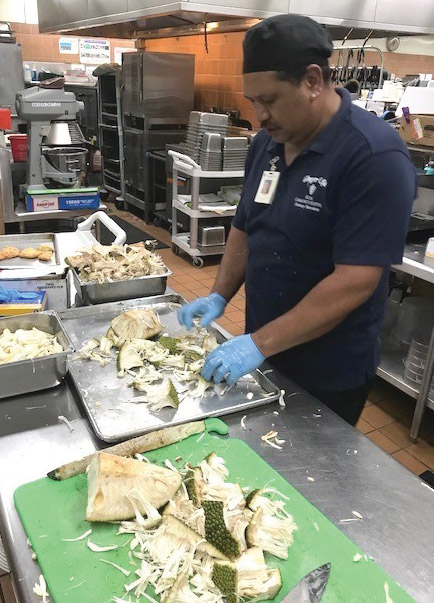
photo courtesy of KCH
“Everyone is so happy!” Judy says. People are excited about meals, and the staff takes greater pride in the meals they are preparing. “Our dietary staff has really blossomed under the initiative,” Judy remarks. Local favorites, like kālua pork with cabbage and chicken long rice, are menu staples. Vegan options such as broccoli alfredo and roasted cauliflower are routinely featured. Thereʻs even ahi tuna, “right out of the waters of West Hawai‘i,” Judy says with a chuckle.
The Ginger Café kitchen team proves that if they cook it, people will come. After the new menu unveiling, the cafeteria is serving more meals than ever before. Much to everyoneʻs surprise, vegan dishes have been a big hit amongst Ginger Café diners.
“Theyʻre actually good; I like the healthy options,” Kalani, a nurse at the hospital, says. “Iʻm bringing this home for my husband to try,” Kalani adds as she purchases a vegan brownie. She also chose a local tangerine from the snack bar for herself.
With a smaller menu, the dietary team has fewer items to prepare, so staff has more time to put into each of them. Amber Martin, a dietary team member, enthusiastically points out the desserts sheʻs made—vegan black bean brownie, chocolate chia seed pudding, and strawberry cheesecake—all are enticingly displayed in healthy portion sizes. As the kitchen team readies for dinner service, Amber returns proudly with a tray of garlic-glazed pork chops fresh out of the oven.
The modest changes to the menu have led to tastier food and higher customer satisfaction. It has also created more loyalty, so the team is serving more meals than ever before. Breakfast has been the most popular meal with a 103 percent increase in sales, catering is a close second with a 50 percent jump, and dinner sales increased by 23 percent.
The education of staff has also been twofold. With the help of Blue Zones and Beyond Green, hospital employees have learned about food and nutrition while at work. They have also gained awareness of how to make their favorite dishes healthier, taking the information and knowledge home with them. Famous chef Sam Choy even visited Ginger Café, cooking alongside Amber and the rest of the dietary team, giving them tips and tricks of the trade.
In addition to improving the wellbeing of staff members and patients, the hospital is also now an economic driver for Hawai‘i Island agriculture, helping build resiliency in our fragile food system. Kona Community Hospital is also creating more awareness of utilizing fresh local ingredients within the community.
Ninety percent of the food consumed on Hawai‘i Island is imported. Kona Community Hospital is helping change that by sourcing more than 50 percent of their ingredients from local farms. Local produce is fresher and picked at peak ripeness. The end result is a delicious and more healthful meal. A common deterrent to sourcing locally-grown produce is the perceived expense. By switching to locally-sourced products for a large portion of the menu, Ginger Café has actually decreased their food expenses by four percent. Switching over to local produce has also significantly reduced food waste.
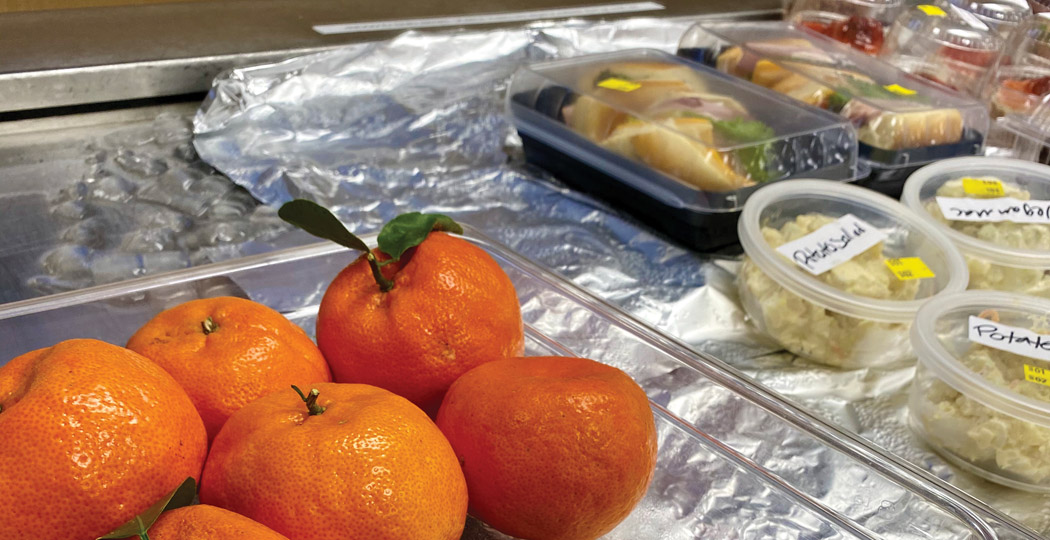
Patients Benefit, Too
In 2019, Kona Community Hospital spent $100,000 on local fruits, vegetables, meat, and fish, and they are on pace to spend that much, or more, in years to come as the hospital expands their dietary reach. A new initiative started in January 2019, to bring the caféʻs meals into patient rooms. Now, patients without specific dietary restrictions can enjoy the same locally-grown offerings as they would in the cafeteria.
The decision to roll out the Ginger Café menu to patients was an easy one. As the farm-to-table menu gained moment and popularity amongst employees and guests, it was clear that the dietary team’s scratch cooking was making an impact. By increasing the café team’s reach, the hospital could have more buying power within the community and offer patient’s a healthy locally-sourced meal, prepared right onsite. Today, patients look forward to their in-room meal delivery when staying at the hospital.
Forward-thinking and striving for even more positive community impact, two of the Kona Community Hospital dieticians are looking at developing an educational outreach program centered around diabetes nutrition. Sharing a rough overview of the plan, Judy explains theyʻd like to create a community outreach program to focus on fresh local food and making food from scratch, not processed, to help diabetes patients live a happier, healthier life.
Kona Community Hospital is one of the largest employers on the west side of the island. As such, they feel a great responsibility in helping their employees make healthy choices during their day. They also recognize their ability to add to the financial viability of the local farmers, ranchers, and fishermen of Hawai‘i Island, strengthening our local food system in the process.
Creating a menu focused on what people loved eating—what made them feel nurtured—built a stronger connection between employees and the food they were served or serving. Engaging the Kona Community Hospital staff in the whole process, from sourcing ingredients to recipes, energized the entire hospital and continues to inspire the community around them. ❖
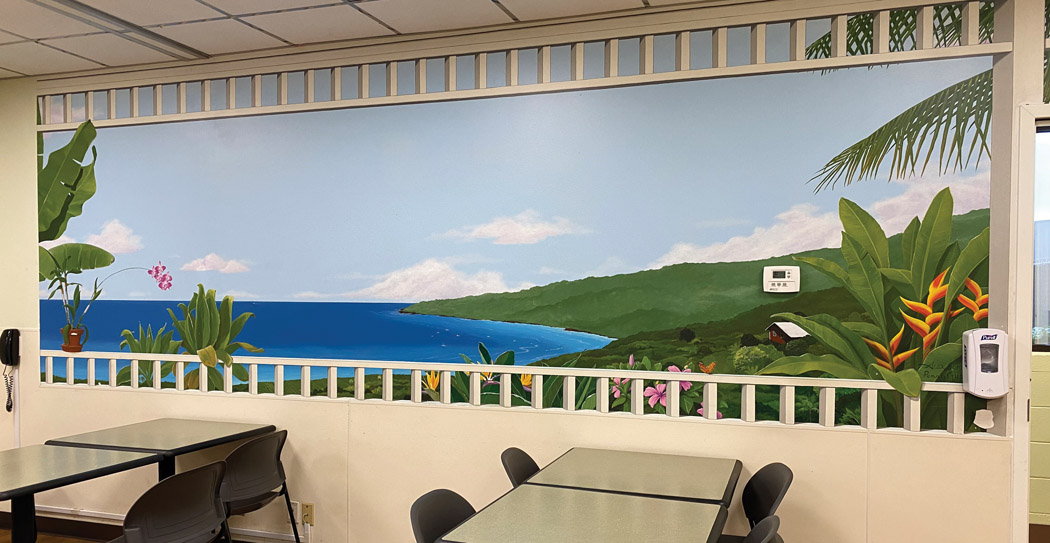
For more information: kch.hhsc.org

